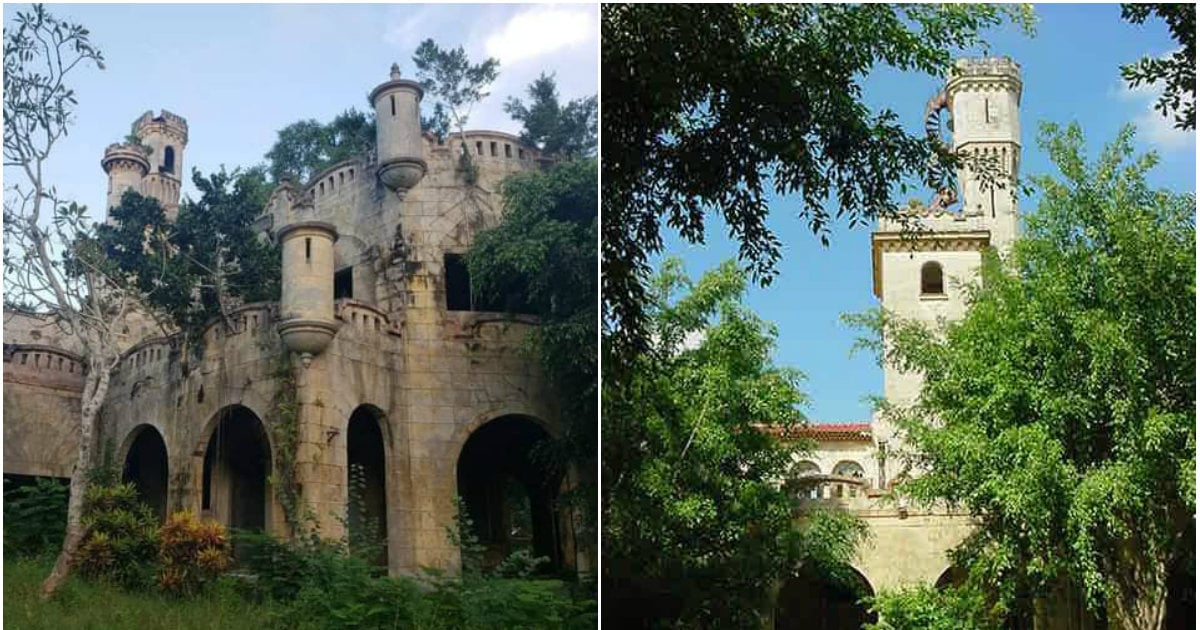
In Arroyo Naranjo there is an abandoned mansion that few Havana residents know about. Belonged toJose Manuel Cortina García, a prominent Cuban lawyer, politician and diplomat, recognized in his time for being an excellent speaker.
Cortina was one of the first oligarchs to see his fortune decimated with the triumph of the revolution. Among the great riches that were confiscated from him was his mansion, known asFinca La Luisa.
There is little information about who designed this mansion and in what period it was built. However, many Cubans agree on the importance of highlighting its architectural value and preserving its memory for future generations.
The ruins of Finca La Luisa
Finca La Luisa is a reinforced concrete mansion on the outskirts of Havana. It has a design Inspired by the fortress palaces of the Italian Renaissance, especially the Florentines. This evocation can be seen in the battlements, watchtowers and sentry boxes, which characterize the building.
Its entrance is located in theVarona Highway. It is currently abandoned and in ruins, but it still retains a halo of beauty in its overall design and its interior rooms.
The reminiscences of hisostentatious past They coexist with structures of later construction that were used to divide rooms and create offices in theResearch Center for the Mining-Metallurgical Industry (CIPIMM).
This company was foundedErnesto Guevara (Che) in 1967. It is currently attached to the Ministry of Energy and Mines (MINEM) and occupies another building on the same road.
Who was José Manuel Cortina García?
Jose Manuel Cortina (1880 Pinar del Río – 1970, Miami) was born in the “Ingenio Moreno”, near San Diego, in Pinar del Río. He came from a wealthy family.
At a very young age he settled in Cárdenas where he dedicated himself to importing machinery for the sugar industry. He then began training as a producer and became a prominent technician in this branch. Had onegreat work capacity which allowed him to manage several mills simultaneously.
It is said that Cortina was aman of high learning abilities, with a special inclination towards topics of Agriculture, Latin Classics and Rhetoric. He graduated fromUniversity of Havana in the specialty of Civil and Public Law.
José Manuel Cortina, a determining character in Cuban politics
José Manuel had an important role in the political sphere in Cuba, where he began to stand out as a university student. Wasfounder of the Cuban National Party (1899).
From this stage he showed signs of his extraordinary oratory powers. In this sense he had a very personal style, celebrated by famous figures in Cuban history such asGeneral Maximo Gomez. Such was his prestige that he came to be considered the “speaker of the Republic”.
He was elected representative of the Chamber (1916), senator (1924) and laterSecretary of the Presidency during the government of Alfredo Zayas, who served as the fourth president of the Republic between 1921-1925.
José Manuel Cortina is attributed the authorship of the“Work Accident Law” and of theNational Commission for Propaganda and Defense of Habano Tobacco (1925). He was an advocate for this product nationally and internationally.
In the government ofMiguel Mariano Gómez (1936) acted as Minister of State, as in the first term of theGeneral Fulgencio Batista (1940-1944).
Cortina had a prominent role in the constitutional convention that drafted theConstitution of 1940. On this occasion he participated as a delegate from the Cuban capital. In addition to his political work, he was a journalist and published more than30 works of a social, economic and political nature.
Why did a man like José M. Cortina bother the revolution?
José Manuel Cortina was a defender of democracy and it was a manextremely rich. At the triumph of the Revolution it wasconsidered a landowner.
He owned more than150 vegas of tobacco; extensive land for breeding and fattening horses, cattle and pigs; Coffee, oranges, mangoes and other varieties of fruits were produced on their lands; wasbee honey exporter, a product that has disappeared from Cuban homes.
It had pine forests andplanting of timber trees and developed a wildlife protection policy on its properties, limiting hunting and incorporating new species that reproduced freely. He was a defender ofdiversity of agricultural crops for development.
In addition to hisFinca La Luisa, had another very famous one in Cuba, which was also intervened at the beginning of the revolution, “Hacienda Cortina”. He was the owner ofLa Güira Park, theCaves The portals, large farms and up to five rural schools, where more than 400 children studied.
Why was Finca La Luisa confiscated?
At the triumph of the RevolutionThey confiscated thousands of properties in Cuba, many under the pretext of being “misappropriated assets” and that their owners had enriched themselves at the expense of the public treasury and illicit businesses.
Cortina owned significant amounts of land in Pinar del Río. It is said that their properties extended from the Sierra del Rosario to the Sierra de los Órganos.His entire fortune was reduced to 30 caballerias.
As indicatedEcured, José Manuel Cortina “was forced to acknowledge” before a court that he was subjecting his workers and peasants to double exploitation, with salaries below the real value of the tobacco crops that he sold on the international market.
After losing all his properties, he emigrated to the United States and died in Miami, Florida in 1970. Today his great treasures belong to the Cuban State and most of them are unproductive or lyingin the ruins and in oblivion, like Finca La Luisa.
What do you think?
SEE COMMENTS (4)Filed in: